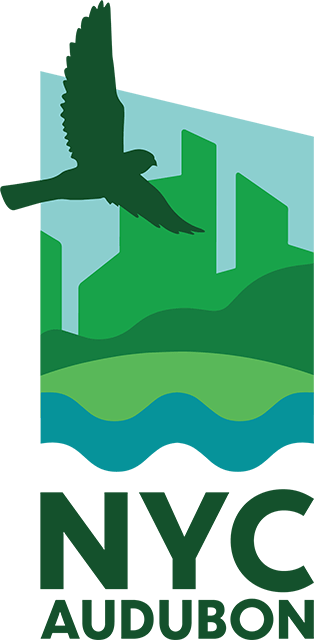Manhattan HotspotsClick on a park below to see it on the map.
The Battery
Bryant Park
Carl Shurz Park
Central Park
East River Park
Fort Tryon Park
Fort Washington Park
Governors Island
Highbridge Park
Hudson River Park
Inwood Hill Park
Madison Square Park
Morningside Park
Peter Detmold Park
Randall's Island
Riverside Park
Riverside Park South
Roosevelt Island
Swindler Cove Park and Sherman Creek
Tompkins Square Park
Union Square Park
Washington Square Park
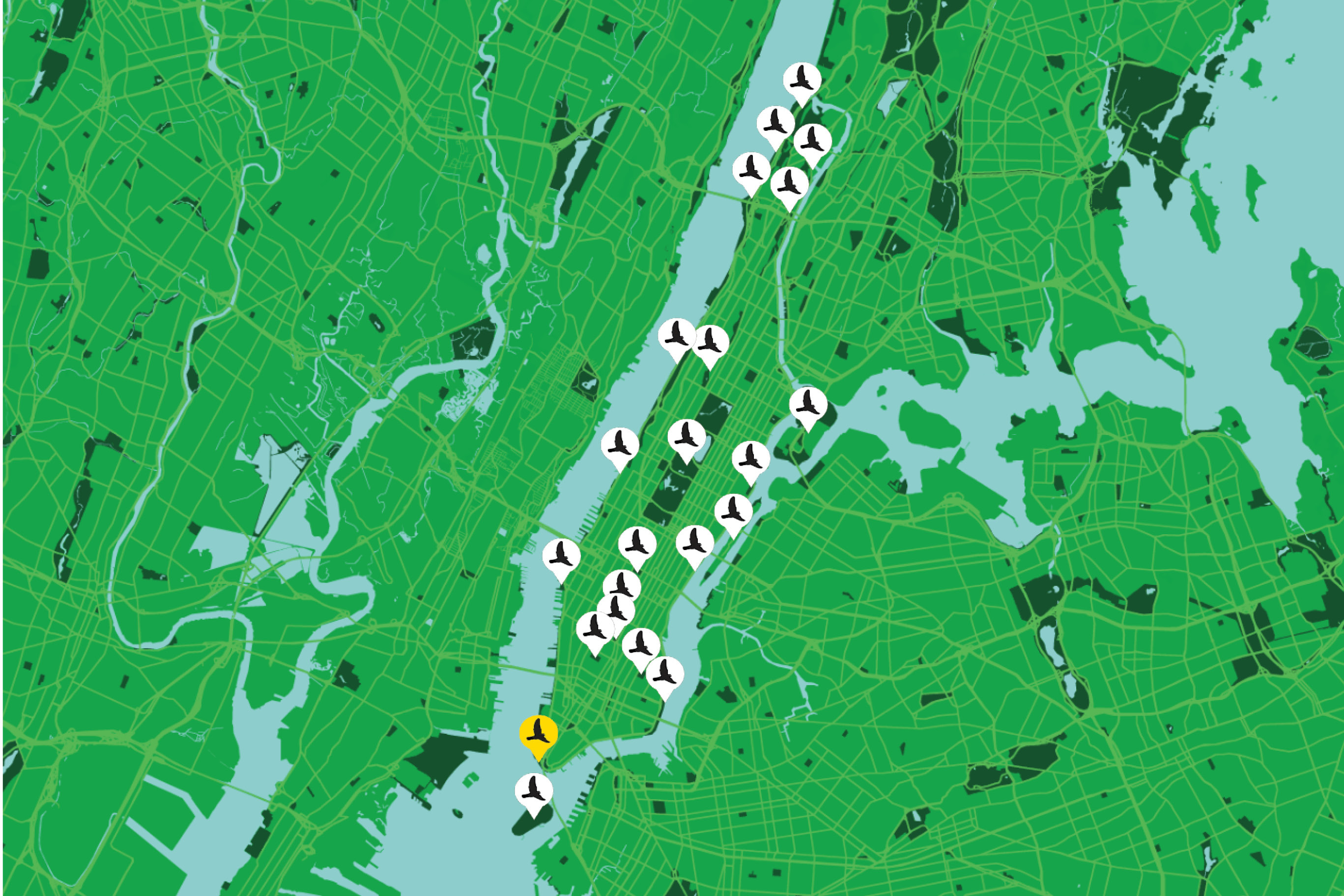
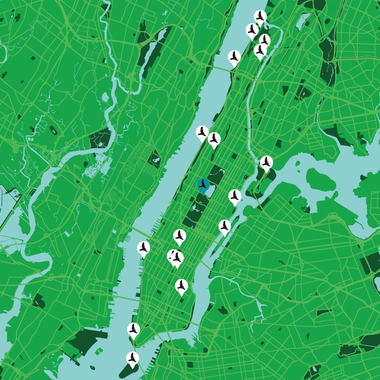
BIRDING IN MANHATTAN
Incongruous as it may seem to those who haven’t yet discovered birds in the Big Apple, birding enthusiasts come to New York City from all over the world to watch birds. In the midst of soaring skyscrapers and seemingly endless expanses of asphalt, the green shapes of our parks call out to birds during migration. In spring and fall, millions of songbirds, raptors, and waterbirds migrating along the Atlantic Flyway pass right through New York City, and funnel into our green spaces to rest and refuel.
This effect may be at its strongest in Manhattan, due to the density of development and the few green oases available. Central Park and Inwood Hill Park are the largest of these habitats, but migrants have many more spots to choose from: a series of green patches along Manhattan’s coast, including Riverside Park, Highbridge Park, Swindler Cove Park, East River Park, and The Battery, also attract great numbers of birds. Formally arranged urban parks that lack large areas of natural habitat, such as Bryant Park and Washington Square Park, can also attract a great variety, as can even smaller “pocket parks.” Finally, several developed islands in the borough of Manhattan—Randall’s, Roosevelt, and Governors Islands—offer excellent bird habitat, while a couple of very small Harbor Heron islands in the East River, off limits to the public, host nesting egrets, cormorants, and gulls.
Manhattan’s parks are extremely well birded, both by the City’s birding enthusiasts and by visitors from across the globe. A total of 340 species have been recorded in the borough, according to Manhattan (New York County) eBird records, including 39 warbler species (not including hybrids). Surprising birds such as Virginia Rail, Sora, Eastern Whip-poor-will, Saltmarsh Sparrow, and, in particular, American Woodcock regularly show up in the most unexpected of places, as they attempt to navigate the City’s terrain during migration. Greater rarities documented over the years have included White-tailed Tropicbird, South Polar Skua, Anhinga, Purple Gallinule, Rufous Hummingbird, Hammond’s Flycatcher, Couch’s Kingbird, Harris’s Sparrow, Swainson’s Warbler, and Kirtland’s Warbler.
Manhattan’s habitats also host quite a few breeding species that one might not expect in such a dense metropolis: nesters include Peregrine Falcon, American Kestrel, Red-tailed Hawk, Great Black-backed and Herring Gulls, Hairy Woodpecker, Great Crested Flycatcher, Northern Rough-winged Swallow, Warbling Vireo, Wood Thrush, Cedar Waxwing, Yellow Warbler, and both Baltimore and Orchard Orioles. Great Horned, Barn, and Northern Saw-whet Owls are regularly found roosting in Manhattan parks over the winter.
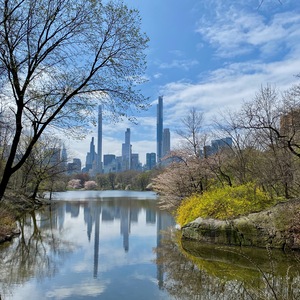
A view of the Central Park Lake from the Oak Bridge entrance to the Ramble. Photo: Bill Benish/CC BY-NC-ND 2.0
Central Park
The long green rectangle of Central Park stands out on any map of Manhattan, and it stands out to the droves of migrating birds of all kinds that flock here during migration. Songbirds such as warblers, tanagers, and grosbeaks are particularly plentiful here, but anything from Eastern Whip-poor-wills to American Bittern may be found on the right migration day. Naturally managed areas—from the Hallett Nature Sanctuary at the park’s southern end, to the famous paths of the Ramble and the expanse of the Reservoir, to the wild North Woods and Loch—attract an incredible variety of bird life throughout the year. Birders from near and far have documented 268 bird species in Central Park.
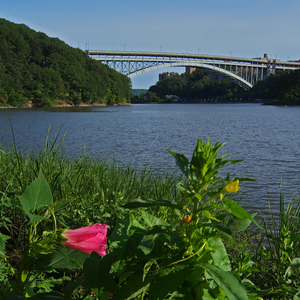
Inwood Hill Park. Photo: Steve Guttman/CC BY-NC-ND 2.0
Inwood Hill Park
At the Northern tip of Manhattan stands one of the richest and wildest woodlands in New York City, on the steep slopes of Inwood Hill. The park’s towering oak and Tulip Poplar forest attracts songbirds galore during migration, and is home to nesting Wood Thrush and Hairy Woodpecker. The forest overlooks Muscota Marsh, one of the few remaining salt marshes in Manhattan, which attracts waterfowl and shorebirds, while the park’s orchard-like meadows bring nesting Orchard and Baltimore Orioles and Warbling Vireos. The park affords striking views of the Hudson River; Bald Eagles are a frequent sighting on the river from nearby Dyckman Street pier, particularly in winter time.
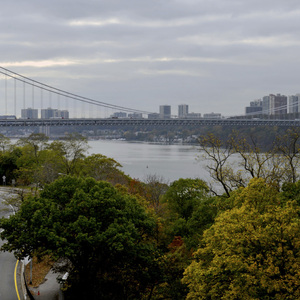
Many parks along the Hudson River, including Fort Tryon and Fort Washington Parks, provide rich habitat for birds and stunning views of the river and New Jersey Palisades. Photo: Eddie Crimmins
Hudson River Parks
Starting from just below Manhattan’s northern-most wildlife habitat, Inwood Hill Park, a series of preserved green spaces along the island’s western Hudson River shore provide refuge for birds in wooded areas and gardens, along with views of waterbirds and raptors on the Hudson. From north to south, these hotspots include Fort Tryon Park and the Cloisters, the Riverside Park Bird Sanctuary, Hudson River Park, and at Manhattan’s southern tip, The Battery. Locals who diligently “bird their patches” find all sorts of rarities in these waterside parks—from Bald Eagles to Barred Owls to Evening Grosbeaks—and after a migration “fall out,” birds can appear in astounding number and variety.
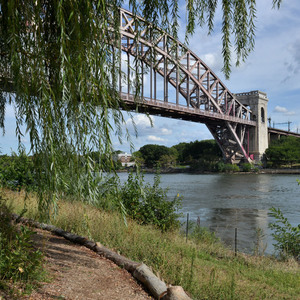
View of the Hell Gate Bridge from a waterside path on Randalls Island. Photo: Eddie Crimmins
Harlem & East River Parks
Manhattan’s East Side is bordered by the Harlem River and East River, and a series of green spaces have been both preserved and reclaimed along the island’s length, providing bird habitat and public access to the waterfront. From north to south, Sherman Creek, Swindler Cove, Highbridge, Carl Schurz, Peter Detmold, and East River Parks all attract birds and offer views of the Bronx, Queens, and Brooklyn across the water, while Randall’s and Roosevelt Islands provide additional habitat, mid-river. Though particularly important as stopover sites during migration, these parks also host nesting raptors and songbirds, and provide foraging for waterbirds nesting on several Harbor Heron islands in the East River.
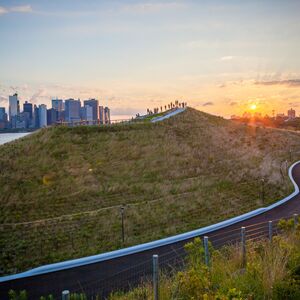
The sun sets over the Hills of Governors Island. Photo: Justin Kiner/CC BY-NC-ND 2.0
Governors Island
Governors Island was opened to the public in 2005, following a long history of military use, lastly by the U.S. Coast Guard. The island has become increasingly known as a birding hotspot, following the discovery of a Common Tern colony on its eastern side, a returning nesting pair of Yellow-crowned Night-Herons, and a restoration of the southern portion of the island that includes extensive native plantings. Its location in the middle of the upper harbor makes it a prime stopover spot for migrants in need of rest. NYC Audubon welcomes visitors to a seasonal nature center at Nolan Park House 17, as part of a program run by the nonprofit Trust for Governors Island. Governors Island’s growing eBird list totals 215 species.
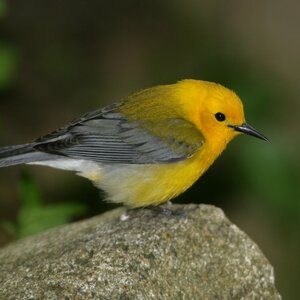
A Prothonotary Warbler takes a rest in Bryant Park. Photo: Avi Lewis
Bryant Park
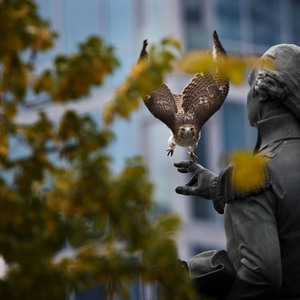
A Red-tailed Hawk comes in for a landing (on George Washington’s hand) in Union Square Park. Photo: François Portmann
More Manhattan Hotspots
Perhaps the most striking aspect of the “Central Park effect,” or the high concentration of migrant birds in the City’s parks, occurs outside of Central Park: Plaza-style urban parks not usually thought of as wildlife habitat, such as Madison Square Park, Tompkins Square park, and even smaller neighborhood green spaces, are often visited by unusual birds during migration. Today, the word gets out quickly through social media when a rare bird is found anywhere in New York City, and birders descend to see the rarity. Unusual sightings in Manhattan’s smaller parks have included Sora, Virginia Rail, Cattle Egret, Chuck-will’s-widow, Couch’s Kingbird, Kentucky Warbler, Mourning Warbler, and Scott’s Oriole.
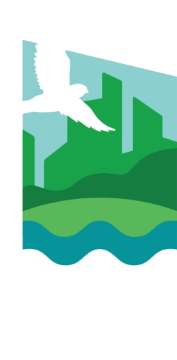
 park locations
park locations